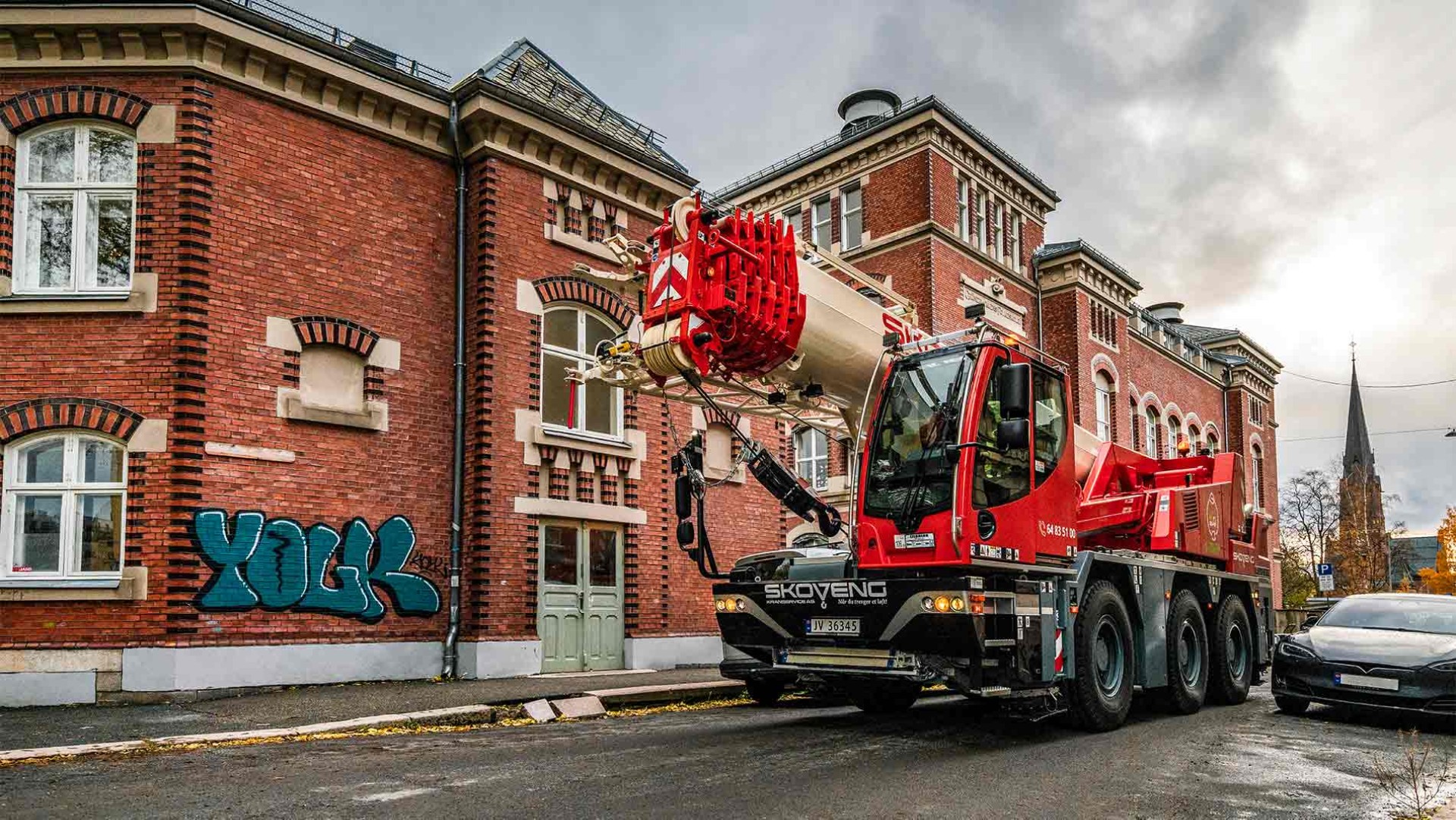
10 minutes - magazine 01 | 2024
Sound of silence
Norway is considered the country of electromobility par excellence in Europe.
Liebherr LTC 1050-3.1E - Northern Europe’s first hybrid compact crane in operation
In 2023, the percentage of new electric or hybrid cars was well over 90 percent. As early as next year, for example, cars with combustion engines will no longer be allowed to be used in Oslo city centre. And the capital is also increasingly requiring emission-free machines for its construction sites. Construction machinery with combustion engines may only be used in public-sector construction and infrastructure projects if no electrically powered alternatives are available. This puts great pressure on the construction industry to look for suitable equipment. In November last year, the first Liebherr compact crane was put into operation in Oslo. Although it drives to the construction site with a combustion engine, it can carry out all work there with zero emissions and no noise using site electricity: the Liebherr LTC 1050-3.1E.
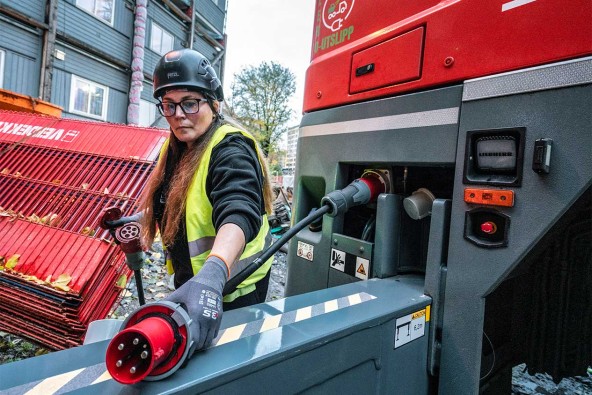
Power point - Siv Hege Barstad draws the energy for her crane from the construction site’s power supply.
A construction site in the middle of Oslo in autumn 2023. It is located between a school and a kindergarten. Excavators, cranes and many construction workers are building a new multi-purpose hall on the sports grounds. There is a lot of hustle and bustle. But there is also something else: silence. At least relative silence, because every now and then one of the men swings a hammer, an angle grinder spins at full speed or an impact drill fires a loud salvo into the concrete. But then calm returns. And this despite the fact that excavators and cranes continue to work as normal. Almost none of this can be heard, because the machines are all powered by electricity. The quiet humming is easily drowned out by the noise of the schoolchildren streaming outside and onto their football pitch at break time.
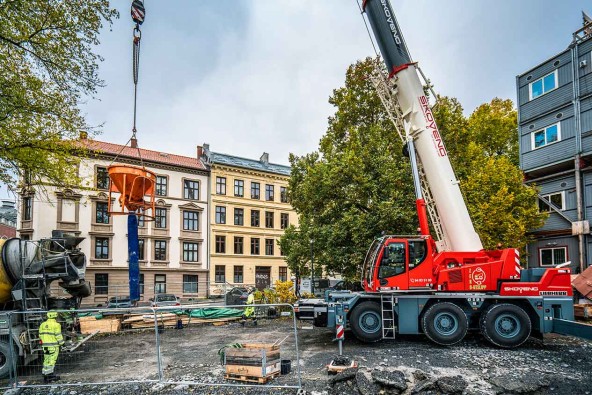
“The neighbours of construction sites will love us!”
The crane assembling the formwork for the long concrete walls on the construction site that day is our new LTC 1050-3.1E compact crane. This hybrid-powered mobile crane is the first that we have delivered to Northern Europe. It was ordered by Skoveng Kranservice AS, a company based in Lillestrøm. The company, which operates in the cities of eastern Norway, but primarily in Oslo and its densely populated surrounding area, has ordered five of these cranes in one go, replacing a large part of its crane fleet. Together with a Liebherr MK 88-4.1 mobile construction crane, half of the fleet now consists of equipment that can also be operated electrically. “With these machines, we are now in a very strong position,” says Lars Christian Steen, Managing Director of Skoveng, explaining his purchases. “For crane work in buildings or during night operations, the noise-free and pollutant-free machines are of course ideal. Those living near these construction sites will love us! Even today, only emissionfree machines without engine noise may be used on construction sites at night in Oslo. And from 2025, this will apply across the board,” says the busy company boss. A green logo with the words “Zero Utslipp” (zero emissions) is emblazoned on each side of his bright red crane.
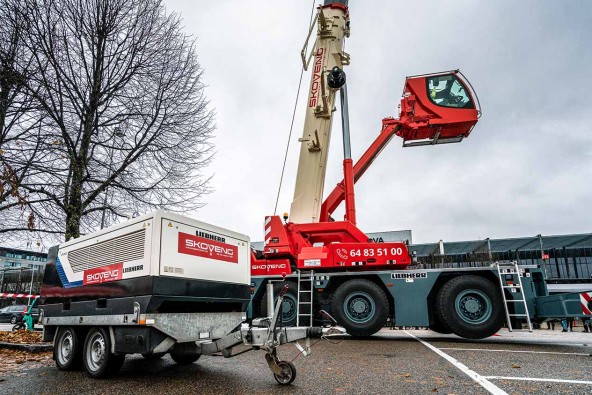
Bundle of energy - The Liebherr Liduro Power Port type LPO 100 supplied the power for the demonstrations at the crane presentation.
But this advertising alone is not enough for Lars Christian Steen. To publicise his new electric cranes, he invited people to Lillestrøm for a crane initiation ceremony. Prominent politicians, building contractors, public officials and also competitors of Skoveng Kranservice celebrated the launch of the LTC 1050-3.1E at Norway’s largest exhibition centre. A Liebherr Liduro Power Port type LPO 100 was available as the power source for the crane demonstrations. The mobile energy storage system based on lithium-ion batteries has a capacity of 100 kWh. On construction sites with limited or no mains connection, it can supply electrically powered equipment with energy. “The battery should last for about one normal working day of an LTC 1050-3.1E,” explains Joachim Eußem from Liebherr-Components GmbH, who travelled to Norway with the new compact crane to demonstrate the storage system. “The LPO 100 will be available from 2024 and, the following year, there should be the Liduro series with a total of five power ranges. The largest of these will have a storage capacity of 160 kWh.”
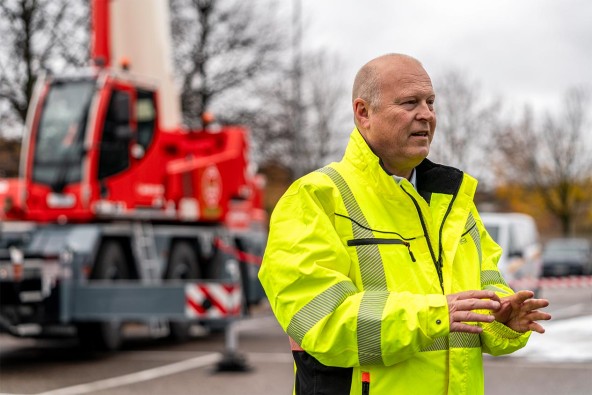
“In a strong position” - The conversion of half the crane fleet to hybrid equipment will bring the company important orders from the construction sector, Skoveng Managing Director Lars Christian Steen is certain.
Oslo soon to have ten Liebherr hybrid cranes
Tommy Borgring, who is responsible for sales in Scandinavia and the Baltic States at the Liebherr plant in Ehingen, did not miss the presentation of our hybrid crane. Born in Sweden, he was instrumental in driving this project forward. “We have now sold ten of these electrically powered machines in the Oslo area. A new water supply system will be built in the capital over the next few years. Among other things, there is a large construction site where three of these E-LTCs will be working in tunnel construction,” says Borgring. “In the Scandinavian countries in particular, great importance is attached to the fact that construction machinery can also be operated electrically. That’s why we are currently working flat out to electrify more machines.”
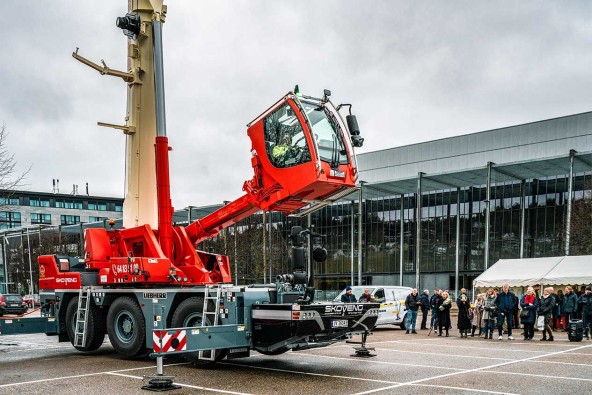
See and be seen - The presentation of the new Liebherr crane took place in front of an audience at Norway’s largest exhibition centre.
Siv Hege Barstad sits in her brand new Liebherr crane on the day of the presentation and impresses the guests again and again with how far she can telescope her cab upwards. “On the construction site,” says the crane driver, “that’s a real advantage when it comes to safety. If I can’t see enough from below, I can drive up to a height of almost eight metres and look over walls, for example. This means I always have a very good view of what’s happening on my construction site.”
This is where Siv Hege steers her crane vehicle again the next morning. Work on the hall construction mentioned at the beginning continues and the crane is urgently needed. The young woman has been working as a crane driver for six years. “However, I have always worked with all-terrain mobile cranes and it was quite a change for me to sit in the same cab during on-road driving and when working with the crane,” she explains. “But it works very well.” The journey from the company headquarters to the job site through the capital’s rush-hour traffic goes smoothly. With a width of just 2.55 metres, the LTC 1050-3.1E gets through everywhere. “The vehicle is simply very manoeuvrable. I can also use it to drive into the city centre without any problems. The chassis is generally very versatile when it comes to manoeuvring in tight spaces.”
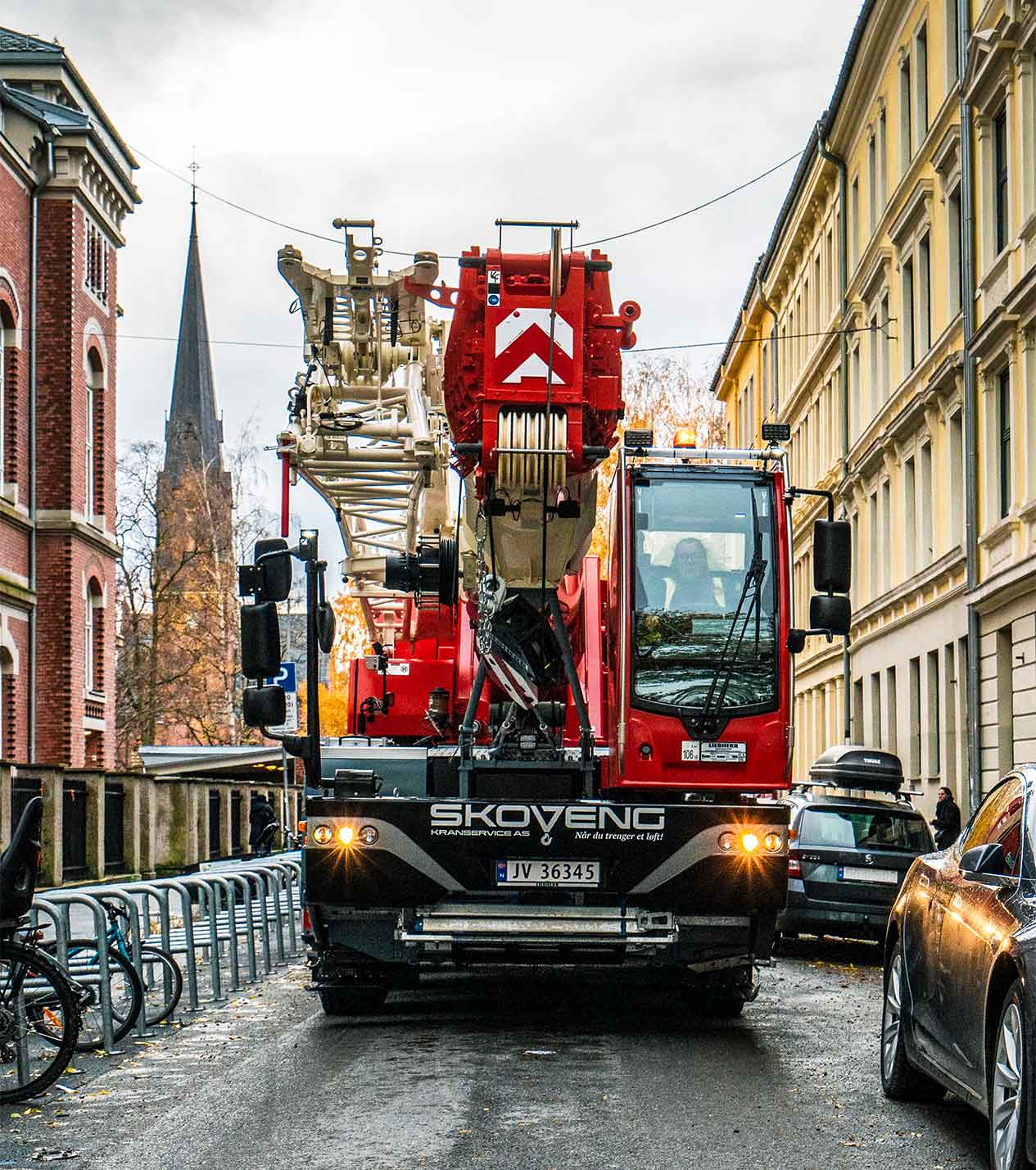
Suitable for city centres - With a width of just 2.55 metres, the LTC 1050-3.1E also fits through narrow alleyways or streets with parked cars.
“Unusual, but very pleasant”
The crane’s steering programmes and compact design are also extremely useful on the current construction site. In the furthest corner of the site crane and driver are already awaited. “The large construction crane is currently busy elsewhere and I’m taking over the concreting work here for a while,” explains Siv Hege. She routinely positions the machine, extends the crane supports and pushes the plug of the on-site power cable into the socket of her crane. Then she swings into the cab and the work starts almost silently. “I can also operate the crane with 125 amps, in which case it works just as fast as with its combustion engine. I don’t notice any difference when swivelling, lifting or telescoping. On the construction site here, however, I only have 63 amps of power available, so it’s a bit slower.” However, this drop in performance is only noticeable when several crane movements are being carried out simultaneously and require energy. If, for example, only the hoist is operated, the process is almost as fast as with a current of 125 amps.
On the construction site, the crane driver works her way through one truck mixer after the other, lifts the delivered concrete in a bucket to where it is needed and has large formwork panels on the hook from time to time. When asked about her experiences and impressions after the first few days with her new crane in powered mode, she reflects briefly: “It’s a bit unusual when the engine noises are suddenly missing. But it’s also very, very pleasant.”
This article was published in the UpLoad magazine 01 | 2024.



